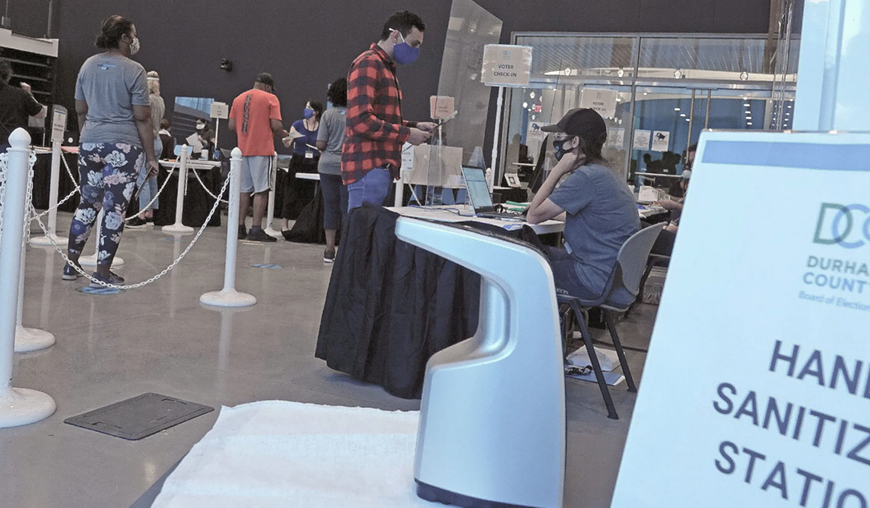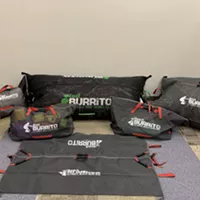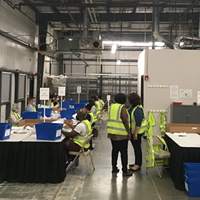Election season enters home stretch in North Carolina
NC in better shape to handle absentee ballots, get results posted earlier than many other states. Counties a mix on transparency of vote counting.
By Mia Chamberlain @missmiafaithAs of Thursday, 852,000 voters successfully submitted absentee-by-mail ballots. By the time all is said and done, elections experts anticipate a total of 900,000 to 1 million absentee ballots cast by mail this election.
This tells us two big things, according to Chris Cooper, a political science professor at Western Carolina University.
Since North Carolina processes absentee ballots before Election Day, most election results will be in on election night; and there could still be enough outstanding votes so that election night totals are not decisive.
“I would encourage folks to go to bed and to wait and to try to figure out, when the dust is settled, what the real answer is,” Cooper said about the election results.
That’s true for the state and the country as a whole.
Because North Carolina has been processing absentee-by-mail ballots as they come in, it is in a better position to finalize election results in a more timely and orderly manner than other swing states like Pennsylvania.
But counties can receive by-mail ballots that are postmarked by Election Day until Nov. 12. The next day, counties are scheduled to make their election results official.
It is quite possible that some races will be clearly decided on election night or that media outlets could call some races if the margins are large enough for late-arriving ballots to not be able to flip the leads.
“I’m trying to not figure out exactly where that line is,” Cooper said, “because the consequences of being wrong are extraordinary.”
At most, 273,000 voters who have requested absentee ballots could still get their votes in by mail, a significant portion of voters who request but don’t return absentee-by-mail ballots.
Many of these voters will decide to cast ballots in person instead. Already, 233,000 of the 1.4 million North Carolina voters who requested by-mail ballots instead voted in person.
This is not a surprise. Charles Stewart III, a political science professor at the Massachusetts Institute for Technology, has been surveying voters for months to get a sense of the methods they would use to cast their ballots.
“I’ve been speculating for months that one reaction to uncertainty among voters could be to request mail ballots as an insurance policy against what might happen as they got closer to Election Day and they couldn’t vote in person,” Stewart said.
To use that insurance, voters must bring their ballots in-person to an early voting site in their county or to their county’s elections office by 5 p.m. Nov. 3. Voters mailing in their ballots have until Nov. 3 to get their ballots postmarked, which can be up to 24 hours after they put it in a U.S. Postal Service dropbox.
Impact of absentee and early voting
This year has seen record turnout before Election Day, both through by-mail and early in-person voting. More than 3,867,000 voters have cast ballots in this election.
That doesn’t leave a whole lot of registered voters left to cast ballots on Election Day, which is good news for election administrators. Fewer voters means shorter lines and, presumably, more flexibility for elections administrators to solve any problems that pop up.
“I don’t think any of us, myself included, understand what a pandemic Election Day looks like,” Cooper said.
But he does have a sense for what the results will look like.
Registered Democratic voters make up 37% of voters who have cast ballots early, Republicans 31%, and unaffiliated with 30%, while 2% comes from the remaining political parties.
Since early votes are uploaded to the elections results page as soon as polls close, Cooper is expecting to see a big Democratic lead at the beginning of the night.
But more Republicans are expected to vote on Election Day.
As the night goes on and Election Day results come in, the state will get redder and redder. The question will be whether Democratic candidates can hold onto their leads.
The only question that will remain at the end of the night is whether any votes are close enough for remaining absentee-by-mail, overseas and military, and provisional votes to change any races.
That will depend on the size of the race and the margin of the election night lead.
Mecklenburg County projects it will have another 20,000 absentee-by-mail ballots come in before the Nov. 12 deadline to accept by-mail ballots. That could have big implications for county-level races, which historically have smaller margins of victory than statewide races.
But the number of ballots arriving after Election Day would have to be much bigger than expected for this to be a “hair on fire” moment, Cooper said.
Pundits around the country have been musing about a situation in which one candidate has a lead on election night that is flipped by ballots that are counted days or weeks after the election.
North Carolina is not likely set up for that scenario, though.
These post-Election Day ballot returns are more likely to lean more Republican than the early by-mail returns, Cooper said, since a lot of them come from military voters.
Voter behavior has also looked different this year.
“We didn’t know how voters were going to respond to changing their behavior radically,” Stewart said.
Historically, people have procrastinated about voting and done it right up against Election Day, Stewart said. For by-mail voting, counties typically see a big swell in returned ballots around Election Day and in the days immediately afterward.
But this year, it looks as if all the early messaging has had an effect to “flatten out the ballot curve,” Stewart said.
This means it is less likely that North Carolina will see a big influx of by-mail ballots at the last minute, though it is still possible. Any by-mail ballot received after 5 p.m. Nov. 2 and before 5 p.m. Nov. 12 will be counted at the county canvass, which is scheduled for Nov. 13.
Observing your county BOE
To cope with the surge in by-mail voting, the General Assembly passed a law in June allowing county boards of election to start meeting five weeks before Election Day to process the incoming by-mail ballots and prepare them to be counted.
On Election Day, counties will count all the early voting and by-mail ballots received by the day before and upload those results to the state election night reporting website when polls close.
Later that night, when precincts close and Election Day results begin to come in, the county boards will meet again.
All of the county board of elections meetings to date have been open to the public. That will change on election night, possibly in violation of the state’s open meeting laws.
Carolina Public Press talked with officials in 10 counties to ask if their meetings would be open to the public.
Each of these counties said the meeting during the day, when board members and election staff are counting absentee votes, will be open to the public. In-person availability will be limited due to COVID-19 precautions in most counties, though Buncombe and Forsyth counties said the proceedings will only be viewable online.
Watching the election results come in is a different matter.
Seven counties — Buncombe, Cherokee, Durham, Guilford, Mecklenburg, New Hanover, and Wake — said voters could watch the precinct totals come in, though Buncombe’s will still only be online.
Forsyth, Granville, and Mitchell said this process would not be open to the public. That was the position in Wake County during the March primary, but the board changed its stance after members of the public complained about a lack of transparency.
The only guidance the state board would offer is to point to open meetings law, with the highlighted section “a majority of the members of a public body for the purpose of conducting hearings, participating in deliberations, or voting upon or otherwise transacting the public business within the jurisdiction, real or apparent, of the public body.”
That would seem to suggest that all board of elections meetings on Tuesday should be open and viewable to the public.
Click HERE for the broadcast script.
Speaking of...
Latest in News Feature
More by Mia Chamberlain
Calendar
-
 Cirque du Soleil: OVO @ Bojangles' Coliseum
Cirque du Soleil: OVO @ Bojangles' Coliseum -

Coveted Luxury Watches
-

TheDiscountCodes
-

Queen City R&B Festival & Day Party @ Blush CLT
-

R&B Music Bingo + Comedy Show @ Blush CLT

















